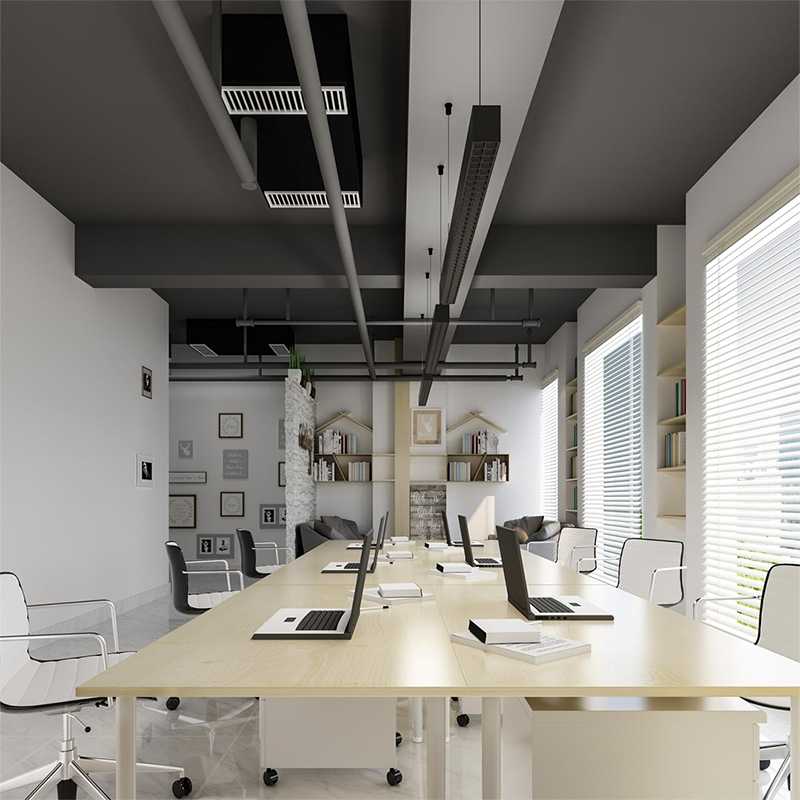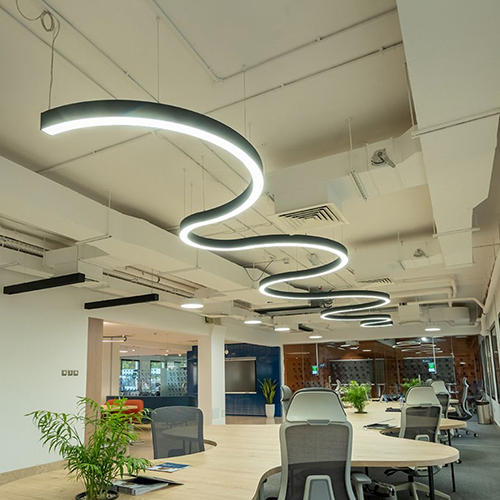Why 4000K Can’t Wake You Up?
—Reunderstanding Office Lighting
You think 4000K is the “gold standard” for office lighting?
You believe color-temperature-adjustable lights can regulate biological rhythms? In fact, the impact of lighting on human health and cognition goes far beyond our intuitive understanding of “color temperature.” What truly drives our alertness, focus, relaxation, and sleep is the spectral fingerprint of light, an “invisible system” that lies beyond the human eye but governs circadian rhythms.
I. From Color Temperature to Spectrum: The Starting Point of Evolving Lighting Understanding
1.1 CCT: Color Temperature is Just “What Light Looks Like”
Correlated Color Temperature (CCT) is a familiar lighting index used to express whether white light “looks cold or warm.” For example, 2700K looks like yellow light, and 6500K like blue-white light. However, this is just a simplified model at the visual level and cannot reveal the “biological effects” of light.
1.2 SPD: Spectrum is the “DNA” of Light
Spectral Power Distribution (SPD) describes the energy distribution of a light source across each wavelength between 380-780nm, serving as the complete fingerprint of its physical and physiological effects. CCT is merely a simplified “label” extracted from SPD. Two light sources with completely different SPDs can have the same CCT—a phenomenon called metamerism, which is hard to distinguish visually but leads to huge physiological differences.
How Light Affects the Body: From Visual to Non-Visual Pathways?
2.1 The Third Type of Photoreceptors: Melanopsin and ipRGCs
In addition to rods and cones, scientists have discovered a third type of photoreceptor in the human retina—intrinsically photosensitive retinal ganglion cells (ipRGCs). These cells are sensitive to blue-cyan light (~480nm) and rely on melanopsin to perceive light. They do not participate in imaging but regulate sleep, hormone secretion, body temperature rhythms, and more.
2.2 From Eye to Brain: The Circadian Rhythm Pathway
ipRGCs transmit light signals directly to the suprachiasmatic nucleus (SCN) in the hypothalamus, which acts as the “master biological clock” coordinating the body’s physiological rhythms. Blue light stimulation during the day inhibits melatonin secretion and increases cortisol levels, keeping us awake. However, blue light exposure after dusk delays sleep time and disrupts the rhythm system.
Psychology and Cognition: The Potential Impact of Light on Human Behavior
3.1 Cool Light = Focus, Warm Light = Relaxation? Not Necessarily
Although intuitively, cool light is associated with attention and warm light with relaxation, studies have found:
- High color temperature light can enhance alertness but may negatively affect creative tasks.
- Some experiments show higher task completion efficiency in warm light environments, especially for work requiring innovative thinking.
- Subjective preferences may not align with physiological performance: people prefer 4000K, but perform better under 6500K.
3.2 Psychological Effects of Light: Cultural, Gender, and Individual Differences
Emotional associations with light are also influenced by culture and habits. In Eastern cultures, white light may be linked to mourning, while in Western cultures, it symbolizes purity. Meanwhile, women prefer lower illuminance and warm light environments. This means ideal lighting design should be task-adaptable, culturally adaptable, and individually adjustable.
Criticisms and Challenges to Static Lighting Standards
4.1 Where Does the “Safe Harbor” of 4000K Come From?
China’s GB 50034 “Code for Lighting Design of Buildings” recommends that the color temperature of LED lighting in long-term workplaces should not exceed 4000K. This was a “conservative strategy” when early LED technology was immature, aiming to avoid glare caused by high blue light. However, this regulation can no longer meet the current multiple needs for rhythm support, emotional regulation, and efficient work.
4.2 A Constant Light Environment Day and Night = A Source of Physiological Disturbance
Providing a single neutral color temperature throughout the day cannot wake the body in the morning nor guide the natural release of melatonin in the evening. It is a “flat lighting” that disrupts circadian rhythms, leading to sleep disorders, reduced daytime productivity, and exacerbated “social jet lag.”
Human-Centric Lighting (HCL): From Visual Lighting to Rhythm Lighting
5.1 Definition: Lighting Centered on People, Not Spaces
Human-Centric Lighting (HCL) uses lamps with adjustable spectrum and intensity to simulate the rhythmic changes of natural light, promoting human health, mood, and work performance.
5.2 Technical Core: Spectrum Management Capability
- Tunable White systems: Adjust CCT between 2700K-6500K.
- Full-spectrum LEDs/multi-channel spectrum control: Precisely control energy in specific wavelength bands, strengthen or weaken the ~480nm melanopsin-sensitive band, breaking the limitation that “color temperature adjustment does not equal rhythm regulation.”
5.3 Application Strategy: Dynamic Spectrum Schedule for Office Spaces
| Time Period | Recommended CCT | Physiological Goal |
| 8:00-12:00 | 5000K-6000K | Wake up the body, inhibit melatonin |
| 13:00-16:00 | 5000K→4000K | Resist drowsiness, maintain focus |
| 16:00-18:00 | 4000K→3000K | Slow down rhythms, prepare for rest |
| Evening | <3000K | Protect sleep quality |
Basic Lighting Quality Cannot Be Ignored
- Illuminance: At least 300-500lx (on work surfaces).
- Glare control: UGR < 19 (applied value), using lamps with good shielding angles.
- Color rendering performance: High color rendering lamps meeting TM-30 standards.→ High color rendering affects not only objects but also facial skin tones, food, and spatial atmosphere, making it a core foundation of a comfortable environment.

Practical Approach: “Zoned Bimodal Strategy” for Limited Budgets
If a full HCL system cannot be deployed, a bimodal + zoned lighting strategy can still be adopted:
| Area Type | Recommended CCT | Functional Goal |
| Work/Focus Zones | 5000K | Maintain alertness, focus on tasks |
| Rest/Collaboration Zones | 3000K | Relax, socialize, reduce rhythm burden |
This works better than a uniform 4000K across the office, benefiting both health and efficiency.
The Future of Lighting: From “Illuminating” to “Empowering”
With the rapid development of AI, sensors, and personalized big data, lighting will also become an active health management tool—it will no longer be just a decorative element of space but an intelligent “invisible doctor” connecting physiology, psychology, and behavior.
Designers, standard-setters, developers, and lighting brands should reconstruct lighting strategies from the three-dimensional perspective of spectrum, timing, and intensity, truly realizing the evolution of a “people-centered” light environment.










